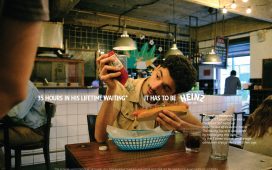
Each and every one of us has an innate drive to connect to others.
Brands to watch are stepping up and helping spark those connections.
Humans are social animals. We think, create, consume and process our work, ideas, interests, concerns and questions through interacting, aligning and sharing with others. This is community. It’s the very essence of what it means to be human.
The past three years left us with a collective experience deficit. The pandemic not only devastated entire industries overnight, it also challenged people’s wellbeing and ability to thrive.
“The pre-pandemic world and consumer landscape of the past aren’t coming back. That doesn’t mean what lies ahead isn’t full of promise, but brands have to stop wishing for what used to be. ”
So, where do we go from here?
Opportunity is out there
Brands are no longer built based on how they are portrayed. Now, brands are built based on how
they behave.
This challenge highlights the importance of developing relationships beyond transactional interactions. More than ever, people crave belonging and want to identify with like-minded people. Consumers expect brands to foster this kind of connection and conversation.
This is your moment to embrace change and lean into disruption.
At Spiro, we’re doing that by being more creative and courageous in how we harness and deliver the future to our clients, the industry and the world. We do that through future-casting, macro-trends, strategic foresight, and innovation as a core of our value proposition. It’s so central that we launched an innovation and thought leadership arm that drives what we think about the future, what we see in our industry, and how we guide and support our clients.
Here are three things brands can watch for and take action on:
Understand the current landscape
The pre-pandemic world and associated consumer landscape of the past aren’t coming back. That doesn’t mean what lies ahead isn’t full of promise, but brands have to stop looking behind them and wishing for what used to be.
Companies that seek to latch on to a state of normalcy, or have a ‘back to business’ mentality, rather than moving toward our collective evolution, will lose relevancy in even their most basic value propositions.
Conversely, brands that pay attention to the economic, cultural, and behavioural shifts happening all around us – what we at Spiro call ‘the New Now’ – can embrace change by innovating new business models and offering new brand experiences.
That’s the key to thriving, not just surviving, in this continuing shifting landscape.
Figure out where your customers are
If you’re not already focused on your customers’ choices and preferences first and foremost – figuring out what drives, motivates, inspires, and concerns them – you should start now.
Otherwise, you’re just another brand adding noise instead of value.
Recognise that this moment is all about customer empowerment. It’s not about you or your brand, it’s how you can meet your customer where they’re at, wherever and whenever that is.
The post-Covid customer persona has drastically changed, so even if you think you know your consumer, think again.
Use experiences to create community
Networking happens when you want someone; community happens when someone wants you, too. It’s a subtle difference with a big impact that starts with a connective moment or experience and grows into a sustaining body.
To become a brand to watch, building a community should be your overarching goal. This means mobilising members to think and act collectively, sharing ideas and holding each other accountable for effort and performance. Instead of building a network that benefits only the individual, the focus is revealing ways individuals within the community can give value to each other.
When individuals give value to one another, they also give value to your brand.
Consider Lego: In 2003, the company was $800m in debt.
So, it turned to its fans. Leaning into its community – not only reaching out to understand its customers and their needs, but also to get them actively involved in the creation process – gave Lego the ability to build itself back up.
By 2015, its brand valuation was roughly $5.4bn. In 2021, that valuation grew to roughly $9.1bn. Today, its thriving community of fan creators vote on ideas that become sought-after products carrying high price tags.
It’s important to remember that community isn’t a throwaway concept. Creating community-centred experiences isn’t a new coat of paint. Instead, it’s a way to reimagine your brand and its value through the eyes of your consumers –and engage with them year-round in a way that’s mutually beneficial.
Are you ready to embrace the New Now?









